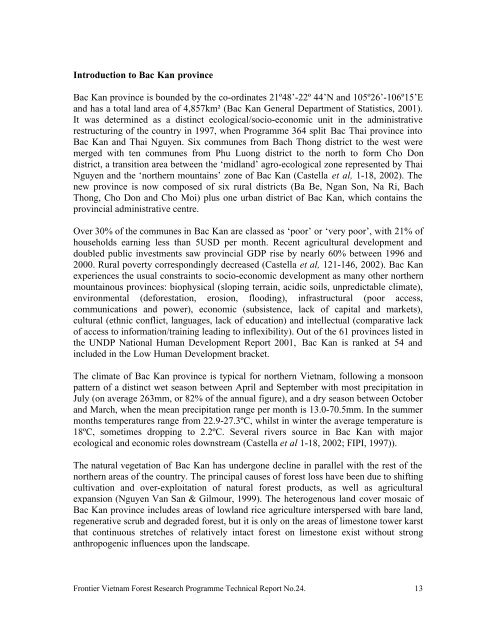Kim Hy Proposed Nature Reserve - Frontier-publications.co.uk
Kim Hy Proposed Nature Reserve - Frontier-publications.co.uk
Kim Hy Proposed Nature Reserve - Frontier-publications.co.uk
You also want an ePaper? Increase the reach of your titles
YUMPU automatically turns print PDFs into web optimized ePapers that Google loves.
Introduction to Bac Kan province<br />
Bac Kan province is bounded by the <strong>co</strong>-ordinates 21º48’-22º 44’N and 105º26’-106º15’E<br />
and has a total land area of 4,857km² (Bac Kan General Department of Statistics, 2001).<br />
It was determined as a distinct e<strong>co</strong>logical/socio-e<strong>co</strong>nomic unit in the administrative<br />
restructuring of the <strong>co</strong>untry in 1997, when Programme 364 split Bac Thai province into<br />
Bac Kan and Thai Nguyen. Six <strong>co</strong>mmunes from Bach Thong district to the west were<br />
merged with ten <strong>co</strong>mmunes from Phu Luong district to the north to form Cho Don<br />
district, a transition area between the ‘midland’ agro-e<strong>co</strong>logical zone represented by Thai<br />
Nguyen and the ‘northern mountains’ zone of Bac Kan (Castella et al, 1-18, 2002). The<br />
new province is now <strong>co</strong>mposed of six rural districts (Ba Be, Ngan Son, Na Ri, Bach<br />
Thong, Cho Don and Cho Moi) plus one urban district of Bac Kan, which <strong>co</strong>ntains the<br />
provincial administrative centre.<br />
Over 30% of the <strong>co</strong>mmunes in Bac Kan are classed as ‘poor’ or ‘very poor’, with 21% of<br />
households earning less than 5USD per month. Recent agricultural development and<br />
doubled public investments saw provincial GDP rise by nearly 60% between 1996 and<br />
2000. Rural poverty <strong>co</strong>rrespondingly decreased (Castella et al, 121-146, 2002). Bac Kan<br />
experiences the usual <strong>co</strong>nstraints to socio-e<strong>co</strong>nomic development as many other northern<br />
mountainous provinces: biophysical (sloping terrain, acidic soils, unpredictable climate),<br />
environmental (deforestation, erosion, flooding), infrastructural (poor access,<br />
<strong>co</strong>mmunications and power), e<strong>co</strong>nomic (subsistence, lack of capital and markets),<br />
cultural (ethnic <strong>co</strong>nflict, languages, lack of education) and intellectual (<strong>co</strong>mparative lack<br />
of access to information/training leading to inflexibility). Out of the 61 provinces listed in<br />
the UNDP National Human Development Report 2001, Bac Kan is ranked at 54 and<br />
included in the Low Human Development bracket.<br />
The climate of Bac Kan province is typical for northern Vietnam, following a monsoon<br />
pattern of a distinct wet season between April and September with most precipitation in<br />
July (on average 263mm, or 82% of the annual figure), and a dry season between October<br />
and March, when the mean precipitation range per month is 13.0-70.5mm. In the summer<br />
months temperatures range from 22.9-27.3ºC, whilst in winter the average temperature is<br />
18ºC, sometimes dropping to 2.2ºC. Several rivers source in Bac Kan with major<br />
e<strong>co</strong>logical and e<strong>co</strong>nomic roles downstream (Castella et al 1-18, 2002; FIPI, 1997)).<br />
The natural vegetation of Bac Kan has undergone decline in parallel with the rest of the<br />
northern areas of the <strong>co</strong>untry. The principal causes of forest loss have been due to shifting<br />
cultivation and over-exploitation of natural forest products, as well as agricultural<br />
expansion (Nguyen Van San & Gilmour, 1999). The heterogenous land <strong>co</strong>ver mosaic of<br />
Bac Kan province includes areas of lowland rice agriculture interspersed with bare land,<br />
regenerative scrub and degraded forest, but it is only on the areas of limestone tower karst<br />
that <strong>co</strong>ntinuous stretches of relatively intact forest on limestone exist without strong<br />
anthropogenic influences upon the landscape.<br />
<strong>Frontier</strong> Vietnam Forest Research Programme Technical Report No.24. 13
















